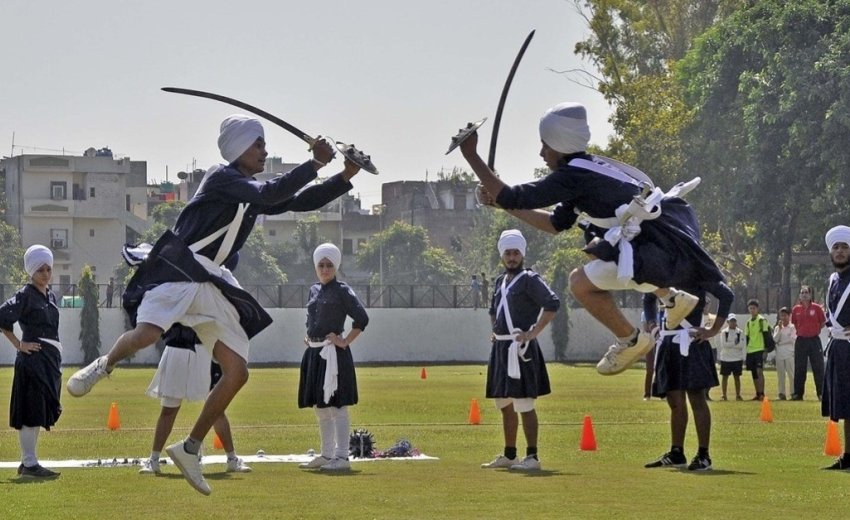In the heart of Newton's Beaver Creek Elementary School, young Ajit Kaur, just eight years old, amazed everyone. She confidently spun a metal circle called a chakra, making it twirl above her head with a long rope. This circle is bigger than two tall adults standing on each other's shoulders.
Ajit handles the chakra gracefully, passing it to another student without stopping. They all practice gatka, an ancient martial art from the Sikh tradition, here every Tuesday night. Her parents watch as coaches Mahabir Singh and Gurdit Singh guide the children. Everyone helps out because they love this activity. The original version of the chakra rotating above Ajit’s head was a flat steel ring that was lethal up to 50 metres in experienced hands. Long ago, the chakra was a powerful weapon, and you might have seen a similar one on TV with Lucy Lawless in "Xena, Warrior Princess."
What is Gatka?
Gatka, a martial art linked mainly to Sikhs from Punjab and related groups, is a style of stick-fighting where wooden sticks represent swords. The name ‘gatka’ likely comes from the Sanskrit word ‘gada’, meaning 'mace.' Originating in 15th-century Punjab, Gatka experienced a resurgence in the late 20th century. Today, it is popular as a sport and sword dance performed during Sikh festivals.
Origin of Gatka
Gatka is rooted in a martial arts tradition born after the death of the fifth Sikh Guru Arjan Dev in 1606, a tragic event that led to the development of self-defence techniques. Historians have different theories about why the Mughal ruler of that time ordered the death of the fifth guru. Some believe it was because he felt threatened by the growing popularity of the Sikh faith, while others think it was because the guru supported a rebel prince. Regardless of the exact reason, the death of the fifth guru had significant consequences for both the Sikhs and the Mughal Empire.
After the fifth guru's tragic demise, his son, Guru Har Gobind, became the sixth guru. He introduced a practical doctrine of self-protection, which included training in martial arts for both men and women. This led to the development of an efficient martial art designed for easy learning, incorporating various weapons and tactics to enable a small group of fighters to overcome much larger forces. Known as the "warrior saints," they were skilled in using two swords, a sword and a shield, twin wooden quarterstaffs, or other combinations. They were taught to move in circular patterns to cover blind spots, strike decisively, and fight with unwavering courage. The term "Gatka" is commonly associated with the practice stick used by beginners, but some sources suggest it combines two words, signifying grace or liberation and belonging to a group.
Thus, gatka is said to mean “one whose freedom belongs to grace.”
Journey of Gatka: From 10th Guru to now
By the time of the 10th guru, Gobind Singh, Sikh fighters had earned a fearsome reputation. Guru Gobind Singh himself was a skilled archer and horseman, known for his prowess in wielding two swords simultaneously. He led a small group of Sikh warriors against a much larger force of Mughal soldiers in the historic battle of Chamkaur in 1704. Accounts vary, but it is said that a fort defended by 40 Sikhs was surrounded by as many as 700 Mughal cavalry with artillery. Though only a few Sikhs, including the guru, survived Chamkaur, they inflicted significant casualties, marking a turning point that ultimately led to the defeat of the Mughal force. Nowadays, the descendants of those brave fighters continue their legacy on a hardwood floor with basketball markings.
As per an anecdote from 2009, boys and girls enjoyed practising Gatka at Newton’s Beaver Creek Elementary School, Canada.
One student said, “My mom made me come. But I like it now.”
Despite being too young for the program, a well-dressed three-year-old boy, dressed in a tiny turban and mini sash by his grandmother, joins in. He was upset that his older brother got to attend gatka classes, and he didn't want to be left behind. The determined little one follows the older students as they run laps during practice. Soon, practice resumes, and all the students choose bamboo swords from an assortment of training weapons neatly arranged on a cloth in the gym's centre. These young students engage in sparring, constantly vigilant as they circle and watch out for threats from all directions.
Life lessons
Gatka is not just a form of martial art; it is a profound journey of self-discovery and personal growth. Beyond the combat techniques and skills it imparts, it instils discipline and fosters the invaluable attitude of humility. This ancient Indian martial art embodies the rich traditions of martial arts and teaches individuals not only how to defend themselves but also how to navigate life with respect, honour, and humility. This way, individuals not only become skilled warriors but also better human beings, ready to face life's challenges with grace and integrity.

